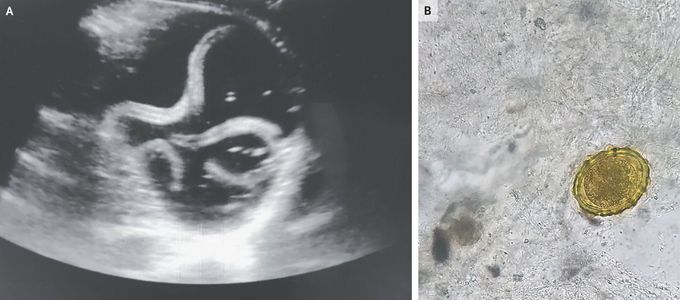


Ascaris in the Stomach
A 20-year-old man presented to the emergency department with a 1-day history of abdominal pain, diarrhea, and vomiting. He had previously been healthy, with no relevant medical history. The heart rate was 96 beats per minute, and the blood pressure was 96/60 mm Hg. On examination, the abdomen was soft and nontender. Laboratory studies showed a hemoglobin level of 19.5 g per deciliter (reference range, 12 to 15), a white-cell count of 20,800 per cubic millimeter (reference range, 4000 to 11,000) with 72.7% neutrophils, and an eosinophil count of 25 per cubic millimeter (reference range, 20 to 500). A point-of-care ultrasound examination of the inferior vena cava was performed to assess the patient’s intravascular fluid status. During the examination, a tubular echogenic structure that moved with a curling motion was seen inside the lumen of the stomach (Panel A and video). Examination of stool for ova and parasites revealed fertilized eggs from roundworms of the species Ascaris lumbricoides (Panel B), and a diagnosis of ascariasis was made. In addition to receiving intravenous fluids, the patient was given a single 400-mg dose of oral albendazole, and he was discharged after 1 day in the hospital. At follow-up in the outpatient clinic 2 weeks after discharge, he reported feeling well and noted that he had passed worms in his stool.
https://youtube.com/shorts/AhO6hyHMPPM?feature=share

